Overview of Philippine Education
The Philippine education system covers both formal and non-formal education. Formal education is a progression of academic schooling from elementary (grade school) to secondary (high school) and tertiary levels (TVET and higher education).
The system is tri-focalized by law into basic, technical-vocational and higher education under three different agencies: the Department of Education (DepED) headed by a Cabinet Secretary for basic education; the Technical Education and Skills Development Authority (TESDA) headed by a Director General for technical-vocational education and training; and the Commission on Higher Education (CHED) under the Office of the Philippine President headed by the Chairperson of a collegial body of five Commissioners.
The country’s colonial history, population growth, financial funding and educational reforms all contributed to the nuances of the Philippine education system.
Structure
The current basic education system consists of a 13-year four-stage program with research-based curricula and methods of assessment that are appropriate to each Grade level at each stage. The stages are Kindergarten to Grade 3 (Primary School; 2) for pupils 5 to 8 years old; Grade 4 to 6 (Intermediate School) for pupils 9 to 11 years old; Grades 7 to 10 (Junior High School) for students 12 to 15 years old; 4) Grades 11 to 12 (Senior High School) for students 16-18 years old.
Formal basic education is provided mostly by public schools which constituted 83% of all basic education institutions in 2017.
An Alternative Learning System is in place as a practical option to the existing formal instruction with DepEd authorized providers. Recognizing non-formal and informal sources of knowledge and skills, learners under ALS can take the Alternative Learning System Accreditation and Equivalency (ALS A&E) Test, formerly known as the Non-formal Education A&E Test which is designed to measure the competencies of those who have neither attended nor finished elementary or secondary education in the formal school system.
Current Reform
This basic education structure is a result of the K to 12 reform which requires Kindergarten and Senior High School. Pre-school education became compulsory in the Philippines only in 2012 with the legislation of the Kindergarten Education Act (Republic Act 10157) although many private elementary schools have prescribed—since the 1950s—one or two years of Kindergarten/Preparatory school for their learners who usually hailed from middle and upper-class families. These private schools include those based on Maria Montessori’s philosophy and the Waldorf School.
Prior to 2012, the Department of Education had pursued initiatives that eventually facilitated the institution of the Kindergarten Program. But two important breakthroughs led to the universalization of Kindergarten: the passing in 2000 of the Early Childhood Care and Development Act (Republic Act No. 8980) and the Barangay (village) Level Total Protection of Children Act” (Republic Act No. 6972). The former law sustained an inter-agency and multi-sectoral collaboration to guarantee delivery of holistic services to children aged 0-6 years old while the latter required all local government units to establish a day-care center in every village (UNESCO, 2016). These laws paved the way for the formally instituted integration of Kindergarten into the Department of Education’s Basic Education Program.
The Enhanced Basic Education or K to 12 Program is inclusive, promoting the right of every Filipino—regardless of age, sex, gender, ethnicity, cultures, and religion–to quality, equitable, culture based and complete basic education. Adhering to a lifelong learning framework, it provides opportunities for all learners to access quality basic education. For instance, learners in difficult circumstances who are prevented from physically attending classes are offered flexible learning options (FLO) to complete their studies while equitable and responsive educational interventions are crafted to give learners with special education needs the opportunities to actualize their potential.
The Senior High School (SHS) Curriculum requires students to choose one of four tracks: 1) Academic, 2) Arts and Design, 3) Sports, and 4) Technical-Vocational-Livelihood. The academic track is further subdivided into four strands: 1) Accountancy, Business and Management (ABM); 2) Science, Technology, Engineering, and Mathematics (STEM); 3) Humanities and Social Science (HUMSS); and 4) General Academic (GAS).
It is important to note that while Senior High School offers tracks and four strands within the Academic Track, SHS graduates–regardless of tracks—can gain admission to Baccalaureate degree programs. Tracking students early and making them progress within the same track is not acceptable in Philippine society, college education for the social mobility of their children being a universal aspiration of Filipino parents.
For this reason, all SHS learners, regardless of track, are required to take 15 core subjects (e.g. Statistics and Probability) to ensure that they are equipped with competencies required for specialization studies in their chosen SHS tracks. In addition, learners are expected to take 16 additional subjects in the Applied Track and in Specialized areas within their chosen Track. Geared toward the acquisition of common but critical competencies in SHS, i.e., English language proficiency, research, ICT, etc., Applied Track subjects are prescribed for learners in all tracks but are delivered with teaching- learning content and strategies customized to the requirements of each track. Figure 3 presents a picture of the basic education curriculum map.
Apart from the K to 12 reform, Philippine basic education has made the paradigm shift to lifelong learning and a learning outcomes-based approach at the level of policy and professional teacher standards and is currently refining its implementation in the classroom.
1.Figure 3. Enhanced Basic Education Curriculum
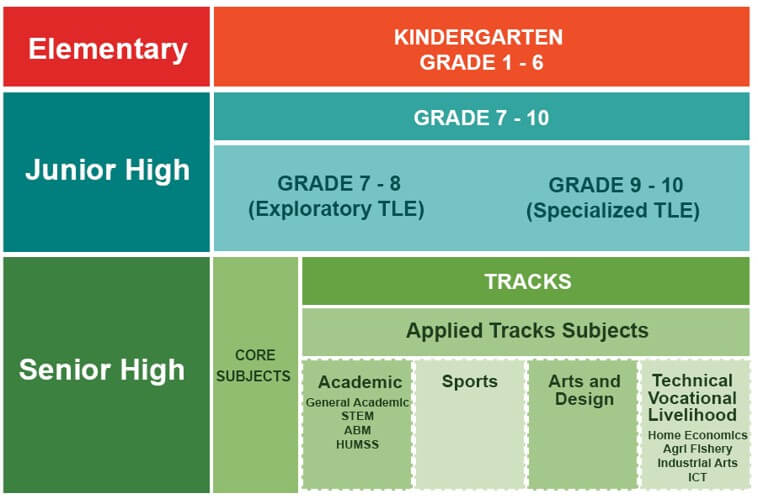
Basic education provides the foundation of the Philippine Qualifications Framework. While a Senior high school diploma does not correspond to any of the PQF levels, a student who completes junior high school may already obtain a qualification at Level I if he or she is passes the certification requirement. A Senior high school graduate on the other hand may acquire qualifications up to Level III upon fulfillment of the requirements for each level.
Governance
The Department of Education (DepEd) fulfills its basic education regulatory mandate through a large organization of 722,710 personnel as of 2017. Its supervisory and regulatory functions are carried out through officials at the Central Office, Regional Directors, Superintendents, Education Supervisors and Principals.
The Department of Education subscribes to School-based Management. While curricular freedom at the basic education level is limited for the public schools directly under its wings, the Department grants some level of autonomy to school heads in managing their schools—e.g. adopting innovative teaching methodologies, resource generation, teacher development programs.
The Philippine Technical Vocational Education and Training (TVET) is a competency-based education and training system strategically designed to meet labor-market demand and provide unskilled Filipinos, opportunities for decent employment and personal advancement. The system subscribes to the principles of lifelong learning and recognition of prior learning by recognizing learning outcomes achieved through formal, informal and non-formal modalities. The qualifications and the skills formation programs are designed in modular form to provide the needed flexibility that allows the packaging of programs according to present and future needs, ease of amendment and an incremental approach to volume and size while addressing the minimum requirements for a qualification.
The TVET system is reflected in the Quality Assured Technical Education and Skills Development Framework or QATESDF (Figure 4) which adheres to the following principles:
- A National Technical Education and Skills Development Plan anchored on national priorities as spelled out in the Philippine Development Plan and in the Investment Priorities Plan; current labor market information; and customer needs. National development priorities spelled out in the national plans as basis for the TESDA Board to draw up the national TVET policies and priorities;
- A system driven by competency standards and training regulations derived from industry requirements and specifications and guided by TVET priorities identified by the TESDA Board;
- Training Regulations as minimum national standards that serve as basis for the development of a competency-based curriculum and learning packages, competency assessment tools and standards and the training and qualification of trainers and assessors;
- Accessibility of the System to a broad range of customers including the unemployed, the underemployed, displaced workers, new entrants to the labor force, technical vocational institutions and enterprise-based training providers;
- Quality of training delivery premised on an efficient and Unified TVET Program Registration and Accreditation System (UTPRAS);
- The incorporation of a competency-based Philippine TVET Qualification and Certification System (PTQCS) that serves as the basis for the grant of national credentials including trainer and assessor certificates;
- Recognition of prior competencies acquired through alternative means and through related work experiences through a system of equivalency within the entire education system;
- Employment and productivity enhancement as ultimate metrics of the technical vocational education and training system to effectively bring about the effective matching of labor supply and demand;
- TESDA-enhanced TVET sector capability and capacity through financial resource management, human resource development, physical resource management, information management, marketing and advocacy, administrative management, customer feedback, management of external relations and environmental concerns;
- The entire system operationalized in a quality management system to ensure continual improvement.
Figure 4. Quality Assured Technical Education System
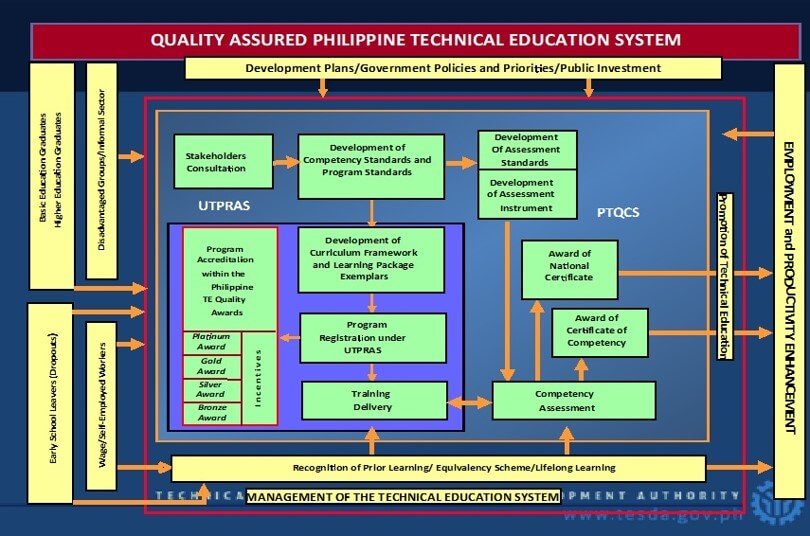
As a competency-based system, Philippine TVET operates on the basis of competency standards developed by industry experts and accepted as an official document after the promulgation of the TESDA Board and subsequent publication in the Philippine Official Gazette. The Competency Standards, together with the training standards and the assessment and certification arrangements for each qualification are packaged into Training Regulations (TR) that are published in national newspapers and uploaded in the TESDA Website. As with the development of Competency Standards, the development and deployment of TRs are governed by quality-assured procedures which are ISO 9001:2008 certified.
Structure, Governance and Regulation
TVET is delivered in the form of training programs that are provided by about 3,920 institutions provided TVET (as of 2017). TVET institutions/training providers are encouraged to develop their own curriculum based on the competency standards/Training Regulations. Adherence to the competency standards, issued under specific Training Regulations, are the minimum requirements for the design and authorization of any TVET training program.
The public TVET providers include TESDA Technology Institutes composed of 59 schools, 15 Regional Training Centers, 43 Provincial Training Centers and 6 Specialized Training Centers. Other public TVET providers include State Universities and Colleges (SUCs) and Local Universities and Colleges (LUCs) offering non-degree programs; Department of Education supervised schools, Local Government Units (LGUs) and other government agencies providing skills training programs.
To ensure greater access, TESDA, through its Centers and designated providers, continues to undertake direct training provisions with four training modalities: school-based, center-based, enterprise-based and community-based. Enterprise-based training is carried out through the Dual Training System/apprenticeship while community-based training is done in collaboration with Local Government Units.
TESDA is the agency mandated by law (Republic Act No. 7796) to 1) promote and strengthen the quality of technical education and skills development programs in order to attain international competitiveness; 2) focus technical education and skills development on meeting the changing demands for quality middle-level manpower; 3) encourage critical and creative thinking by disseminating the scientific and technical knowledge base of middle-level manpower development programs; 4) recognize and encourage the complementary roles of public and private institutions in technical and skills development and training systems; and 5) inculcate desirable values through the development of moral character with emphasis on work ethic, self-discipline, self- reliance and nationalism.
TESDA is the agency mandated by law (Republic Act No. 7796) to 1) promote and strengthen the quality of technical education and skills development programs in order to attain international competitiveness; 2) focus technical education and skills development on meeting the changing demands for quality middle-level manpower; 3) encourage critical and creative thinking by disseminating the scientific and technical knowledge base of middle-level manpower development programs; 4) recognize and encourage the complementary roles of public and private institutions in technical and skills development and training systems; and 5) inculcate desirable values through the development of moral character with emphasis on work ethic, self-discipline, self- reliance and nationalism.
Organizationally, the governance of TESDA, specifically its policy formulation and program approval, rests on a Board composed of representatives of government, industry and employers, workers’ unions and organizations and TVET providers. The composition of Board membership assures that it will be private sector led or dominated although the Board is chaired by the Secretary of Labor and Employment and the Co-chaired by the Secretaries of Education (basic) and Trade and Industry. The Board approves all the policies and plans of TESDA which are implemented by the TESDA executive and regional directors.
Qualifications
Philippine TVET programs provide qualifications from Levels 1 to 4 of the PQF in the form of National Certificates—e.g. animation NC 3, automotive servicing NC2; Bread and Pastry Production NC 2 issued when a candidate has demonstrated competence in all units of competency that comprise a Qualification.
TVET qualifications at Level 5—e.g. diplomas and ladderized programs are at the interface with higher education.
Structure
Degree and non-degree programs at the undergraduate or graduate levels are provided by 1,943 higher education institutions (HEIs) as of 2017—excluding 453 Satellite campuses of State Universities and Colleges. A total of 1,710 or 88% of these HEIs is private. About half of these institutions are small with less than 500 students. While they dominate in numbers, private Higher Education Institutions (HEIs) enroll only 55% of the estimated 4.1 million students in college. The rest study in State Universities and Colleges or Local Universities and Colleges.
In terms of enrollment by discipline, the cluster of business and related programs has the highest enrolment (26%); followed by education and teacher related trainings (21%); engineering and technology (12%); information technology (11%); health-related programs (6%). Enrollment in the other disciplinal clusters make up the remaining 24%.
The process of establishing higher education institutions differs depending on whether they are public or private.
The Commission on Higher Education processes and approves the creation of new private HEIs while State Universities and Colleges (SUCs) are established by legislation with prior inputs in Congressional deliberations from CHED. Local Universities, and Colleges (LUCs), which are oriented to local needs, are created by local ordinance.
CHED grants autonomous and deregulated status—for a renewable period from three to five years—to private higher education institutions that have consistently shown exemplary performance in the provision of education, research and extension services evidenced by their long tradition of integrity and untarnished reputation, commitment to excellence and sustainability and viability of operations. Institutions granted Autonomous Status by CHED demonstrate both exceptional institutional quality and enhancement through internal QA systems and excellent program outcomes. On the other hand, institutions granted deregulated status demonstrate very good institutional quality and enhancement through internal QA systems and demonstrate very good program outcomes.
Institutions granted autonomous or deregulated status benefit in terms of exemption from regular monitoring and evaluation by CHED and priority in the grant of subsidies and other financial incentives/assistance from CHED.
Autonomous institutions have greater benefit in curricular autonomy since they have the privilege to determine and prescribe their curricular programs and they may offer new programs, through the various delivery modes, without securing permit/authority from CHED except in disciplines/degree programs that are under moratorium, the Doctor of Medicine degree, and any other field duly specified by CHED. Autonomous HEIs also has the privilege of offering extension classes.
The institution of undergraduate and graduate programs in private HEIs that are not autonomous or deregulated is authorized by the Commission on Higher Education based on compliance with Policies, Standards and Guidelines (PSGs) developed by legally mandated Technical Panels of experts composed of academics, professional organizations, members of the Professional Regulations Commission (for disciplines leading to regulated professions) and industry representatives (for industry-oriented disciplines). The PSGs set minimum standards operationalized as the minimum set of desired program outcomes in terms of knowledge, skills and values that learners are expected to demonstrate at the end of the learning experience or at the time of graduation.
The charters of SUCs and LUCs assert that their governing boards approve academic programs.
However, except for the University of the Philippines, the country’s national university, the Commission on Higher Education requires SUCs and LUCs to obtain certificates of compliance of programs that were created without going through the CHED technical review and approval process.
The CHED Policies, Standards and Guidelines (PSG) for the various programs have been revised to hew closely with the learning outcomes-based education paradigm that underlies the Philippine Qualifications Framework.
Recognizing the academic freedom of HEIs, CHED allows them to design curricula suited to their own contexts and missions, determine the appropriate means of delivery, the required support facilities and educational resources, and human resource requirements to ensure the achievement of the set program outcomes. The HEIs are also free to design and specify the various aspects of outcomes-based education such as performance indicators, syllabi, means of curriculum delivery, resources deployed, student assessment, program assessment and evaluation and continuous quality improvement. They are expected to establish their internal quality assurance system to keep them in line with expectations regarding key performance indicators such as employability and competitiveness as benchmarked with educational, occupational and industry standards.
To encourage continuous improvement of academic programs, CHED’s incentives to ensure program quality include support for program accreditation by CHED-recognized accrediting agencies. In addition, CHED identifies Centers of Excellence (COEs) and Centers of Development (CODs) in various disciplines in recognition of the exemplary performance of HEIs in the areas of instruction, research and extension with the expectation that these programs will become centers of graduate education and research in their fields of strength and serve as potential catalysts in specific program areas that are needed to enhance scholarship and nation building.
Philippine higher education institutions adopt a semester term, although a few HEIs are authorized to implement trimestral or quarterly terms. The duration of undergraduate study varies. Most of the bachelor or undergraduate programs have a 4-year duration; two programs (architecture and pharmacy) take 5 years to complete and two programs (dentistry and veterinary medicine) have a 6-year duration. The number of years correspond to the applicable term in an HEI (i.e. semester, trimester, quarterly)
CHED recognizes and supports both conventional and non-conventional modes of delivery in higher education. The conventional mode entails traditional face to face classroom interaction between the learners and the faculty members. The common approach involves a variety of instructional methods such as lectures, laboratory experiments, demonstrations, visualization exercise, concept maps, film showing, class and group discussions, problem solving exercises, computer modeling, field trips, tutorials, among others.
Higher education degrees may also be obtained through the following non-conventional models of learning being implemented in the country: 1) open and distance learning (ODL); 2) ladderized education programs; 3) Expanded Tertiary Education Equivalency and Accreditation Program (ETEEAP); and 4) transnational education (TNE) programs.
Qualifications
Undergraduate Education
Undergraduate degree programs in the Philippines are located in Level VI of the Philippine Qualifications Framework.
Their graduates must be able to demonstrate broad and coherent knowledge and skills in their field of study for professional work; apply their knowledge in professional/creative work or research in a specialized field of discipline and/or further study; and be able to work with a substantial degree of independence and or/in teams of individuals in related fields with minimal supervision.
Apart from acquiring undergraduate degrees, passing the licensure examination is an additional PQF Level VI requirement for graduates of disciplines regulated by the Professional Regulation Commission. Without a license, such graduates are not eligible to work in their chosen regulated profession in the Philippines although their baccalaureate degree may qualify them for employment in related professions or in the same profession in countries that do not require a professional license.
o ensuTre the alignment of the licensure examination with CHED’s program Policies Standards and Guidelines (PSGs) for regulated disciplines/professions, a member of the Professional Boards sits in the CHED Technical Committee for a particular regulated discipline and, in this capacity, participates in the formulation of the draft CHED Policies Standards and Guidelines, which are subsequently subjected to a series of stakeholder consultations prior to approval and publication in the government’s Official Gazette. The PSG’s in turn, serve as a basis on which test items in the licensure examinations are formulated (Figure 5).
Figure 5. Alignment of Professional Licensure Examinations with Higher Education Policies Standards and Guidelines
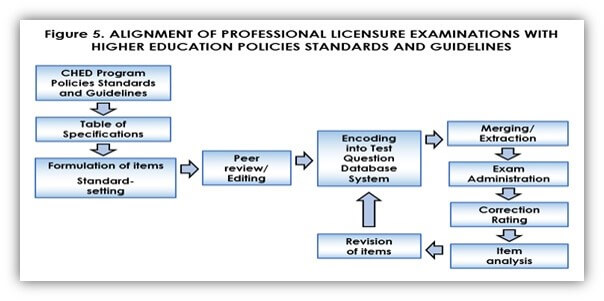
Graduate Education
Graduate education in the Philippines is expected to achieve a clear progression beyond baccalaureate/undergraduate education by underscoring integrative and interrogative teaching and learning contents and methods and recognizably higher competencies in knowledge production (research), knowledge transmission (teaching) and knowledge application (professional practice, vocational arts, technology).
Master’s and doctoral programs in the Philippines have two tracks: Academic or Research Track (PhD by Research) and a Professional Track. Since the Philippine higher education system is heavily influenced by the United States, Master’s or PhD degrees by research is a relatively recent development. The prevailing graduate curriculum is based on coursework with thesis/dissertation.
Lifelong Learning
Lifelong learning entails the institution of pathways and equivalencies that enable individuals to weave in and out of the formal education system while acquiring competencies from non-formal and informal settings that could be credited towards formal qualifications in the formal system.
Such pathways and equivalencies are increasingly put in place to provide different routes to basic education for adult and overage learners. Their path will be determined by their life and employment experiences and their purpose for seeking basic education. The conceptual paradigm in Figure 6 shows the pathways and equivalencies between the formal and alternative basic education curricula and programs.
Beyond basic education, the Philippine Credit Transfer System (PCTS), currently still work in progress, would allow a seamless progression/transition between levels of qualifications. Figure 7 illustrates the possible movement between education levels facilitated through various access ramps or pathways of the respective professions/discipline covering mechanisms for both conventional and non-conventional learning.
Figure 6. Pathways and Equivalencies in Basic Education
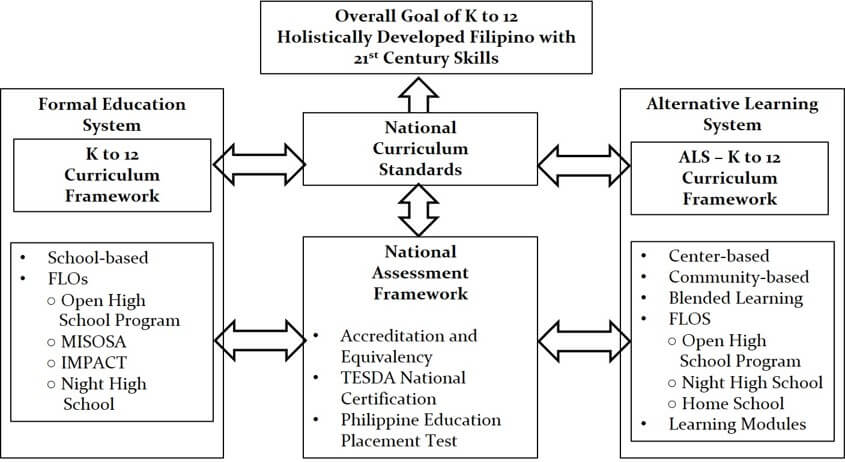
FLOs = Flexible Learning Options
Figure 7. Existing Pathways and Equivalencies Access Ramp

After completion of Senior High School, learners have the option to proceed to higher education, undertake technical vocational training or join the workforce.
Those interested in taking technical-vocational courses after high school may enroll in the various TESDA accredited programs and obtain National Certifications (NC) upon successfully passing the certification process or national competency assessment. National Certification holders may join the workforce at any time or may opt to pursue higher education with possible credits given to their NC or their qualification/competency upon assessment and evaluation or through ladderized education programs (LEP). These programs allow for a steady progression from certificate to diploma to degree learning.
Recognition of prior learning is conferred through validation of competencies achieved in nonformal or informal modes of learning in the Philippine Competency Assessment and Certification System (PTCACS). The validation system utilizes the same competency standards required in the Training Regulation and the system utilizes varied assessment methods applicable to those who achieved competencies through non-formal and informal means.
After completion of Senior High School, learners have the option to proceed to higher education, undertake technical vocational training or join the workforce.
Those interested in taking technical-vocational courses after high school may enroll in the various TESDA accredited programs and obtain National Certifications (NC) upon successfully passing the certification process or national competency assessment. National Certification holders may join the workforce at any time or may opt to pursue higher education with possible credits given to their NC or their qualification/competency upon assessment and evaluation or through ladderized education programs (LEP). These programs allow for a steady progression from certificate to diploma to degree learning.
Recognition of prior learning is conferred through validation of competencies achieved in nonformal or informal modes of learning in the Philippine Competency Assessment and Certification System (PTCACS). The validation system utilizes the same competency standards required in the Training Regulation and the system utilizes varied assessment methods applicable to those who achieved competencies through nonformal and informal means.
Programs providing credit transfer overlap, with some common learning, for which credit can be awarded. There can be credit obtained horizontally from one certificate program to another in a related field, opening career change opportunities for students. Academic degree holders may wish to strengthen their professional skills through addition of an applied technical-level diploma, with appropriate credit transfer from the degree into the diploma. Equivalency also covers associate qualifications which, by definition, bear full credit within a Baccalaureate degree.
Those pursuing college education on the other hand, may choose to accumulate learning credits through the Conventional mode such as formal schooling or through non-conventional modes such as transnational education or open and distance learning. Individuals may also obtain their college diploma through the recognition of prior learning and/or competency standards assessment. College learners may at some point exit school and be subjected to evaluation and assessment to determine their re-entry level. Those who obtain undergraduate diplomas may opt to pursue higher learning through graduate studies or join the world of work and return anytime to proceed to graduate school—while obtaining credits for graduate school-related competencies acquired informally or non-formally in the world of work.
It is worth noting that for the regulated professions, the Professional Regulation Commission and the Professional Regulatory Boards, in consultation with the Accredited Professional Organization/ Accredited Integrated Professional Organization, the Civil Service Commission, other concerned government agencies and stakeholders, are in the process of formulating and implementing Career Progression and Specialization Programs for every profession which shall form part of the Continuing Professional Development. Through Pathways and Equivalencies, the amount of learning earned from CPDs may be accumulated and transferred, allowing a professional to progress from one qualification to another, thus facilitating professional mobility and mutual recognition of professional qualifications.
To date, the PRC Regulatory Boards have already started drafting their respective Career Progression and Specialization. However, they still need to categorize the qualification title of each specialized area appropriate to specific level descriptors in the PQF. A series of workshops and dialogue with stakeholders is scheduled in 2018.
For other regulated qualifications such as in the aviation and maritime industry, the Civil Aviation Authority of the Philippines (CAAP) and the Maritime Industry Authority (MARINA) are mandated by law to develop competencies and qualifications standards in accordance with the international conventions in International Civil Aviation Organization (ICAO) and the International Maritime Organization (IMO) on Standards of Training, Certification & Watchkeeping for Seafarers (STCW), respectively.
Specifically, the CAAP issued the Philippine Civil Aviation Regulations (PCAR) Part II, based on pertinent ICAO requirements, which covers the regulated qualifications for pilots and mechanics adopted by the CAAP through a Board Resolution No. 2011-025 dated April 11, 2011.
The STCW Office of the Maritime Industry Authority (MARINA) provided the framework on the development of the Qualification designed and structured based on the International Maritime Organization (IMO) course format and is required under the 1978 Convention on Standards of Training, Certification and Watchkeeping for Seafarers (STCW) which sets the minimum qualification standards for masters, officers and watch personnel on sea going merchant ships.
The Convention was significantly amended in 1995 and in 2010 the IMO Convention on STCW adopted a new set of amendments in Manila called “The Manila Amendments” to keep the training standards in line with the new technological and operational requirements that require new shipboard competencies
The Philippine Qualifications Framework was established in 2012 through Executive Order No. 83. While its governance is stipulated in the Ladderized Education Act of 2014, the passage of the PQF Act in January 2018 provided the legal support for its full implementation.
The PQF aims to benefit various sectors and stakeholders of education and training by encouraging lifelong learning of individuals; providing employers specific training standards and qualifications that are aligned to industry standards; ensuring that training and educational institutions adhere to specific standards and are accountable for achieving the same; and providing the government with common standards, taxonomy, and typology of qualifications as bases for granting approvals to stakeholders.
The Philippine Qualifications Framework is a collaborative program by the Department of Education (DepEd), Technical Education and Skills Development Authority (TESDA), Commission on Higher Education (CHED) , Professional Regulation Commission (PRC) and Department of Labor and Employment (DOLE).

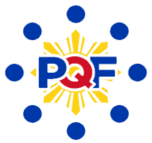
Learn more about The Philippine Qualifications Framework by clicking here.